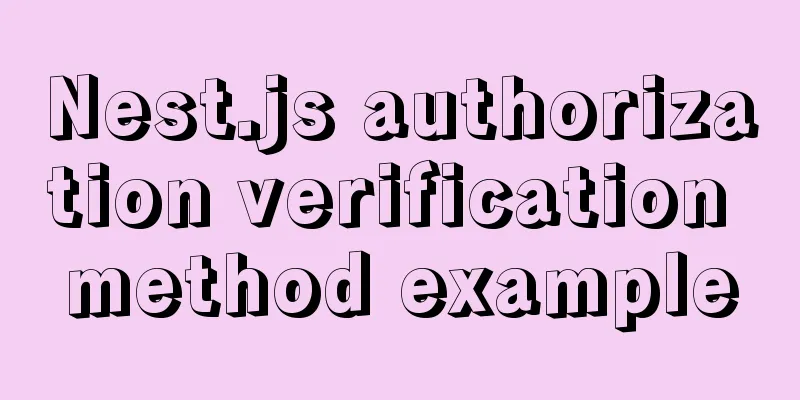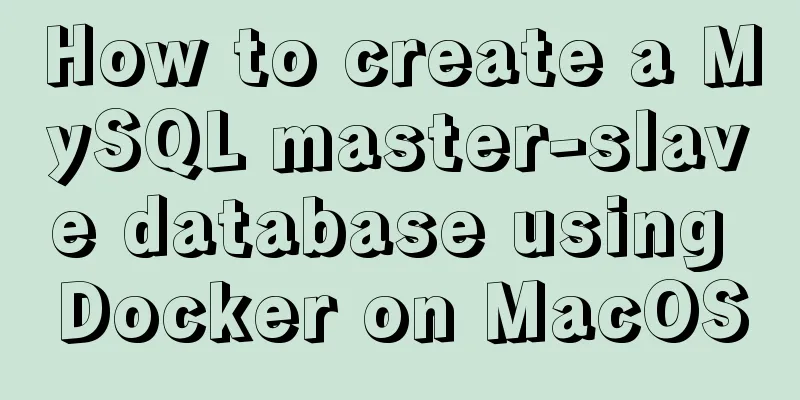Nest.js authorization verification method example

0x0 IntroductionSystem authorization refers to the process of logged-in users performing operations. For example, administrators can perform user operations on the system and manage website posts, while non-administrators can perform operations such as authorized reading of posts. Therefore, an identity authentication mechanism is required to implement system authorization. The following is an implementation of the most basic role-based access control system. 0x1 RBAC ImplementationRole-based access control (RBAC) is an access control mechanism that is independent of role privileges and defined policies. First, create a role.enum.ts file that represents the system role enumeration information:
export enum Role {
User = 'user',
Admin = 'admin'
}
If it is a more complex system, it is recommended to store the role information in a database for better management. Then create a decorator and use @Roles() to run the specified resource roles required for access. Create roles.decorator.ts:
import { SetMetadata } from '@nestjs/common'
import { Role } from './role.enum'
export const ROLES_KEY = 'roles'
export const Roles = (...roles: Role[]) => SetMetadata(ROLES_KEY, roles)
The above creates a decorator named @Roles(), which can be used to decorate any route controller, such as user creation:
@Post()
@Roles(Role.Admin)
create(@Body() createUserDto: CreateUserDto): Promise<UserEntity> {
return this.userService.create(createUserDto)
}
Finally, create a RolesGuard class, which will compare the role assigned to the current user with the role required by the current routing controller. In order to access the routing role (custom metadata), the Reflector tool class will be used. Create a new roles.guard.ts:
import { Injectable, CanActivate, ExecutionContext } from '@nestjs/common'
import { Reflector } from '@nestjs/core'
import { Role } from './role.enum'
import { ROLES_KEY } from './roles.decorator'
@Injectable()
export class RolesGuard implements CanActivate {
constructor(private reflector: Reflector) {}
canActivate(context: ExecutionContext): boolean {
const requireRoles = this.reflector.getAllAndOverride<Role[]>(ROLES_KEY, [context.getHandler(), context.getClass()])
if (!requireRoles) {
return true
}
const { user } = context.switchToHttp().getRequest()
return requireRoles.some(role => user.roles?.includes(role))
}
}
Assume request.user contains the roles attribute:
class User {
// ...other properties
roles: Role[]
}
Then RolesGuard is registered globally in the controller:
providers:
{
provide: APP_GUARD,
useClass: RolesGuard
}
]
When a user accesses a request beyond the scope of the role:
{
"statusCode": 403,
"message": "Forbidden resource",
"error": "Forbidden"
}
0x2 Claims-based authorizationAfter creating an identity, the system can assign one or more declarative permissions to the identity, which means telling the current user what to do, rather than what the current user is. In the Nest system, declarative authorization is implemented in a similar way to RBAC above, but there is a difference. Instead of judging a specific role, permissions need to be compared. Each user is assigned a set of permissions, such as defining a @RequirePermissions() decorator, and then accessing the required permission attributes:
@Post()
@RequirePermissions(Permission.CREATE_USER)
create(@Body() createUserDto: CreateUserDto): Promise<UserEntity> {
return this.userService.create(createUserDto)
}
Permission is similar to the Role enumeration in PRAC, which contains the permission groups that the system can access:
export enum Role {
CREATE_USER = ['add', 'read', 'update', 'delete'],
READ_USER = ['read']
}
0x3 Integrated CASLCASL is a homogeneous authorization library that can limit the routing controller resources accessed by clients. Installation dependencies: yarn add @casl/ability The following is the simplest example to implement the CASL mechanism and create two entity classes: User and Article:
class User {
id: number
isAdmin: boolean
}
The User entity class has two attributes, namely the user ID and whether the user has administrator privileges.
class Article {
id: number
isPublished: boolean
authorId: string
}
The Article entity class has three attributes, namely the article number, article status (whether it has been published), and the author number who wrote the article. Based on the two simplest examples above, we can create the simplest function:
For the above functions, you can create an Action enumeration to represent the user's operations on the entity:
export enum Action {
Manage = 'manage',
Create = 'create',
Read = 'read',
Update = 'update',
Delete = 'delete',
}
Manage is a special keyword in CASL, which means that any operation can be performed. To implement the function, you need to encapsulate the CASL library twice. Execute nest-cli to create the required business: nest g module casl nest g class casl/casl-ability.factory Define the createForUser() method of CaslAbilityFactory to create objects for users:
type Subjects = InferSubjects<typeof Article | typeof User> | 'all'
export type AppAbility = Ability<[Action, Subjects]>
@Injectable()
export class CaslAbilityFactory {
createForUser(user: User) {
const { can, cannot, build } = new AbilityBuilder<
Ability<[Action, Subjects]>
>(Ability as AbilityClass<AppAbility>);
if (user.isAdmin) {
can(Action.Manage, 'all') // Allow any read and write operations } else {
can(Action.Read, 'all') // read-only operation}
can(Action.Update, Article, { authorId: user.id })
cannot(Action.Delete, Article, { isPublished: true })
return build({
// Details: https://casl.js.org/v5/en/guide/subject-type-detection#use-classes-as-subject-types
detectSubjectType: item => item.constructor as ExtractSubjectType<Subjects>
})
}
}
Then import it in CaslModule:
import { Module } from '@nestjs/common'
import { CaslAbilityFactory } from './casl-ability.factory'
@Module({
providers: [CaslAbilityFactory],
exports: [CaslAbilityFactory]
})
export class CaslModule {}
Then import CaslModule into any business and inject it into the constructor to use it:
constructor(private caslAbilityFactory: CaslAbilityFactory) {}
const ability = this.caslAbilityFactory.createForUser(user)
if (ability.can(Action.Read, 'all')) {
// "user" can read and write all content}
If the current user is a non-administrator user with normal permissions, he can read articles but cannot create new articles or delete existing articles: const user = new User() user.isAdmin = false const ability = this.caslAbilityFactory.createForUser(user) ability.can(Action.Read, Article) // true ability.can(Action.Delete, Article) // false ability.can(Action.Create, Article) // false This is obviously problematic. If the current user is the author of the article, he should be able to do this: const user = new User() user.id = 1 const article = new Article() article.authorId = user.id const ability = this.caslAbilityFactory.createForUser(user) ability.can(Action.Update, article) // true article.authorId = 2 ability.can(Action.Update, article) // false 0x4 PoliceiesGuardThe above simple implementation does not meet more complex requirements in complex systems, so we will use the previous authentication article to extend the class-level authorization strategy mode and extend the original CaslAbilityFactory class:
import { AppAbility } from '../casl/casl-ability.factory'
interface IPolicyHandler {
handle(ability: AppAbility): boolean
}
type PolicyHandlerCallback = (ability: AppAbility) => boolean
export type PolicyHandler = IPolicyHandler | PolicyHandlerCallback
Provides support objects and functions for policy checking on each routing controller: IPolicyHandler and PolicyHandlerCallback. Then create a @CheckPolicies() decorator to run the specified access policy for a particular resource: export const CHECK_POLICIES_KEY = 'check_policy' export const CheckPolicies = (...handlers: PolicyHandler[]) => SetMetadata(CHECK_POLICIES_KEY, handlers) Create a PoliciesGuard class to extract and execute all policies bound to the routing controller:
@Injectable()
export class PoliciesGuard implements CanActivate {
constructor(
private reflector: Reflector,
private caslAbilityFactory: CaslAbilityFactory,
) {}
async canActivate(context: ExecutionContext): Promise<boolean> {
const policyHandlers =
this.reflector.get<PolicyHandler[]>(
CHECK_POLICIES_KEY,
context.getHandler()
) || []
const { user } = context.switchToHttp().getRequest()
const ability = this.caslAbilityFactory.createForUser(user)
return policyHandlers.every((handler) =>
this.execPolicyHandler(handler, ability)
)
}
private execPolicyHandler(handler: PolicyHandler, ability: AppAbility) {
if (typeof handler === 'function') {
return handler(ability)
}
return handler.handle(ability)
}
}
Assuming request.user contains a user instance, policyHandlers are assigned via the decorator @CheckPolicies(), using aslAbilityFactory#create to construct an Ability object method to verify if the user has sufficient permissions to perform a specific action, and then pass this object to the policy handling method, which can be an implementation function or an instance of the class IPolicyHandler, and expose a handle() method that returns a Boolean value.
@Get()
@UseGuards(PoliciesGuard)
@CheckPolicies((ability: AppAbility) => ability.can(Action.Read, Article))
findAll() {
return this.articlesService.findAll()
}
You can also define the IPolicyHandler interface class:
export class ReadArticlePolicyHandler implements IPolicyHandler {
handle(ability: AppAbility) {
return ability.can(Action.Read, Article)
}
}
Use as follows:
@Get()
@UseGuards(PoliciesGuard)
@CheckPolicies(new ReadArticlePolicyHandler())
findAll() {
return this.articlesService.findAll()
}
This is the end of this article about the Nest.js authorization verification method example. For more related Nest.js authorization verification content, please search 123WORDPRESS.COM's previous articles or continue to browse the following related articles. I hope everyone will support 123WORDPRESS.COM in the future! You may also be interested in:
|
<<: Summary of MySQL5 green version installation under Windows (recommended)
Recommend
About the value transfer problem between antd tree and parent-child components (react summary)
Project requirements: When you click a product tr...
CSS to achieve particle dynamic button effect
Original link https://github.com/XboxYan/no… A bu...
Summary of the deployment of Tomcat cluster and Nginx load balancing based on Docker
Table of contents Written in front 1. Ngixn image...
Vue implementation example using Google Recaptcha verification
In our recent project, we need to use Google robo...
Docker and portainer configuration methods under Linux
1. Install and use Docer CE This article takes Ce...
Method of building docker private warehouse based on Harbor
Table of contents 1. Introduction to Harbor 1. Ha...
Vuex implements a simple shopping cart
This article example shares the specific code of ...
Front-end JavaScript Promise
Table of contents 1. What is Promise 2. Basic usa...
How to deploy Vue project under nginx
Today I will use the server nginx, and I also nee...
URL Rewrite Module 2.1 URL Rewrite Module Rule Writing
Table of contents Prerequisites Setting up a test...
Comparison of several examples of insertion efficiency in Mysql
Preface Recently, due to work needs, I need to in...
Linux installation apache server configuration process
Prepare the bags Install Check if Apache is alrea...
js canvas implements verification code and obtains verification code function
This article example shares the specific code of ...
Understanding and usage scenarios of ES6 extension operators
Table of contents 1. Replace the apply method, ge...
Detailed tutorial on installing mysql 5.7.26 on centOS7.4
MariaDB is installed by default in CentOS, which ...









